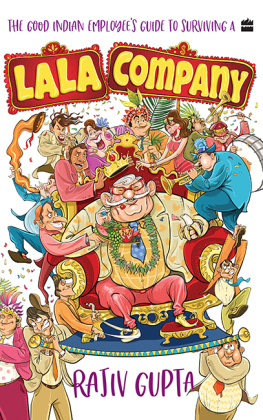
65 Bleecker Street
New York, NY 10012
Copyright 2016 by Rajiv Surendra
All rights reserved, including the right to reproduce this book or portions thereof in any form whatsoever. For information, address Regan Arts Subsidiary Rights Department, 65 Bleecker Street, New York, NY 10012.
First Regan Arts hardcover edition, October 2016
Library of Congress Control Number: 2016939715
ISBN 978-1-68245-050-5
ISBN 978-1-68245-051-2 (ebook)
Interior design by Nancy Singer
Interior and cover illustrations by Rajiv Surendra
Cover design by Rajiv Surendra
Front jacket chalk artwork by Rajiv Surendra
Jacket design by Rajiv Surendra and Richard Ljoenes
Jacket photos by James Tse
TO
SETH ROLAND BAIRD,
EDITOR AND CHIEF AND CHIEF EDITOR,
ICH SAGE AUCH DANKE.
1.
W HEN I WAS a kid, my parents would dress my two sisters and me in traditional Indian garb and cart us off to the Hindu temple in Richmond Hill, where portly bare-chested Brahmin priests in white loincloths chanted sacred Sanskrit prayers in front of huge granite idols. The stone gods were brilliantly dressed in bright red, yellow, purple, and green silks, flower garlands, and jewelry encrusted with precious gems. I was in heaven. Brass bells ringing loudly, ancient fire rituals, and hundreds of other Tamil people packed into the temple, each vying for a glimpse of the idol. Looking up at the smiling face of Vishnu, who would give me whatever I asked for if I prayed hard enough, was something that filled my little two-year-old heart with immense joy.
My religious fervor wasnt restricted to just Hinduism. My Irish aunt Brigid (my uncle had scandalously married outside the Tamil race) took me to Catholic Mass with her on Sundays, and here was yet another story, another house of God soliciting my devotion. A bit more gruesome, with blood dripping from the wounds of this white man hanging on a cross, but still otherworldly. It didnt matter that I couldnt understand a word of Latin, or that I wasnt allowed to go up with Aunty Bridgy to get that little piece of Communion bread and sip of wineshed always sneak back a piece of the wafer for me, whispering that this was where I belonged.
One Sunday, Aunty Bridgy assured me it was okay that we were missing Massthe Holy Mother had appeared to a farmer in a small town three hours away from Toronto, instructing him to gather the flock, for she would come again for those who believed. So there we were in the car, driving for ages along a lone country road, with the hopes that she (excuse me, She ) would show herself to us. We joined hundreds of others who had staked out a claim with their picnic blankets and folding chairs in the farmers field on that sunny fall afternoon. We never did see Mary, but Aunty Bridgy assured me that She was there, in all our hearts. Frankly, just between you and me, I would have preferred to have actually seen what color robe the Blessed Virgin had chosen to wear that day.
Being encouraged to have faith in something that was so incredibly fantastical was fuel for my wild imagination, especially as I got older and it started becoming clear that I wasnt really allowed to live my life in the story-filled world I loved. Ma would throw open my bedroom door on school nights and catch me in the act of jumping off my bed, dressed up as a Greek warrior, practicing my sword-fighting drills, or ceremonially draping a towel over my head and shoulders, a lone Bedouin preparing to cross the Saharathen shed reprimand me for neglecting my math homework. But I couldnt help myself, and I continued to find ways of blurring the lines between the fictitious realm in which I wanted to live, and the real one I was born into.
Our house backed onto a huge valley that bordered the Toronto Zoo, and in the evenings Id hear elephants, lions, and wolves through my bedroom window. I was twelve when I was overcome with the need to play zookeeper myself and build a chicken coop in my backyard. My dad loved the idea, but there was much protesting from Ma. We already had a pet, she said, our little shih tzu named Meesha. Which I had to share with my sisters, I argued; I wanted chickens for myself. They smell, child, Ma insisted impatiently, and they make noise. And I doubt it very much that we are allowed to have chickens in the backyard.
I heaved the giant telephone directory onto the kitchen table one afternoon, looked up the number for the city zoning office, and eventually ended up speaking to a woman who sounded like she was fed up with the mundane questions she had to answer all day.
No, she grunted, youre in a residential zone. No animals of a barnyard nature can be legally kept in your area. We lived in Scarborough, the most eastern suburb of Toronto, in an urban subdivision where the houses were only twenty feet apart. There was a pause, and then she continued, But... we wont know about it unless one of your neighbors complains.
Does that mean I can keep them, if they dont bother the neighbors?! I asked excitedly.
We wont know about it , she repeated, louder this time,... unless your neighbors complain !
Ma finally caved and I filled my coop with Araucana hensa South American breed that lay beautiful blue- and green-shelled eggs. The backyard, laden with the trumpeting of elephants, the occasional roar from a lion, and finally, the soothing sound of six little hens clucking away became my own little kingdom. I was mayor of Chickentown, keeping a watchful eye on my flock and breaking apart petty squabbles as the hens established their pecking order. Giddy with excitement, Id wake up every morning at five and rush down to the backyard to greet my hennies as they emerged from their brooding house, bleary-eyed. Theyd move lethargically and let out long, drawn-out squawks. Id echo back their noises while I filled up their feeding trough and replenished their water. A handful of kitchen scraps never failed to send them into an instant flurry, rummaging fervently through bits of cabbage, carrot skins, and apple cores.
At thirteen, I took my love of quiet, nostalgic domestic practices, like tending to livestock, to the next level when I began volunteering at Black Creek Pioneer Villagea historic site just north of Toronto, where a collection of buildings from the 1800s depicted life in a typical rural Ontario village in the nineteenth century. Twice a month, Id change into my pioneer costume and apprentice with the blacksmith, the cabinetmaker, the baker, or the weaver.
I first went to Pioneer Village on a school trip in second grade, during a mandatory unit on pioneers. My classmates and I were sitting on the pine floor of the farmers log cabin as the tour guide warned our class not to touch anything and then started her spiel, but I couldnt hear herI was completely in awe of the huge squared pine logs that made up the walls and ceiling, the fieldstone fireplace, the flaking red paint on the harvest table and the gnarly wooden bowl that sat on it. Everything here was two hundred years old, yet I felt so at home.
I was always more at peace in my imaginary worlds than beneath the actual roof I lived under. Things werent always pleasant growing up.
Next page















